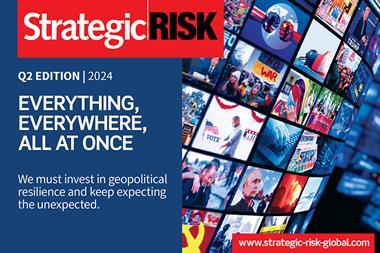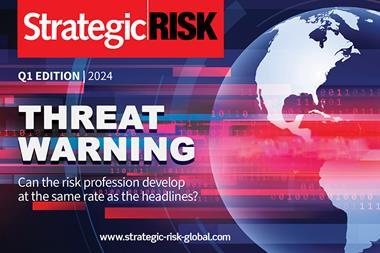Just before the start of this year’s GVNW symposium, GVNW board member and FERMA’s president-elect spoke to StrategicRISK about how he will aim for the future, with a pinch of digitalisation and an eye to the next generation
GVNW’s Dirk Wegener is optimistic, excited and resolute when asked how he will stamp a mark on the Federation of European Risk Management Associations (Ferma), when he will take the hot seat as its president in November. In the meantime he is putting his energy into the 2019 Ferma Forum in Berlin, which he is chairing. “That happens first. I don’t become president until the end, but the theme of the Forum, Aim for the future: entering a new dimension of risk, is a good statement of my vision for my mandate as president.” says Wegener
The Ferma president creates a vision and sets priorities for the board. Accomplishing these objectives is a team effort, according to Wegener. “Ferma has a strong board of diverse, experienced, professionally qualified and engaged members,” he says. A collegiate style is well-suited to the role of leading the umbrella body for Europe’s risk management associations, which represents the interests of 21 risk management associations from 20 countries. Members range from small, tightly-run outfits to large, well-resourced associations with their own annual conferences. Among them, they have nearly 5000 individual members.
Wegener is one of them. He works a day job as global head of corporate insurance at Deutsche Bank Group. To put the size of the job into context: the investment banking and financial services powerhouse based in Frankfurt, Germany, generated pre-tax profits of €1.3 billion on income of €25.3 billion in 2018.
Having started his career in the German insurance industry, Wegener moved into risk management with Daimler Group and then in 2012 with Deutsche Bank. Asked about the early experiences that shaped him as a risk professional, he is quickly transported back to the noughties. “I am old enough to belong to the 9/11 generation. This was a game-changer if you think about the risk landscape,” he says.
Wegener was at his desk in the office of Daimler in Stuttgart, Germany, at the moment the hijacked airplanes struck the World Trade Center’s twin towers. “We all remember where we were and what we were doing. I was working as manager insurance and insurable risk for Daimler. We had business contacts in the US, links to New York. From a personal dimension, it was a tragedy. And if you step back, it was a new dimension in risk from the professional standpoint. The severity of the event was unprecedented. You can see it as a Black Swan, an unknown unknown. Since then, risk managers can hardly think big enough about potential exposures,” he says.
Formative events
The terror attacks showed Wegener how vulnerable to events insurance companies and the insurance industry could be. “It was one of the largest insured losses ever, and it was a shock to the industry. As a system to respond to the financial outcome of such events, the global insurance industry did survive, but it had to adapt. What we saw thereafter were exclusions for terrorism on traditional insurance policies, and the expansion of terrorism risk solutions backed by governments,” he says.
The events altered Wegener’s risk psychology fundamentally, reshaping his ways of thinking about risk and insurance. “This was a new dimension. It produced an awareness that developments in the risk landscape are very difficult to anticipate. Think of climate change. We struggle to fully envision what can happen in terms of severe weather events. It should remind us all not to underestimate what the future can bring. Since then it’s crystal clear that there will always be some unknown unknowns. You just have to accept that you cannot predict everything,” Wegener says.
The unfolding of Solvency II emerged as the other significant influence on Wegener’s career and risk mindset. “The regulation of captives under Solvency II has been a defining event for those who operate a captive insurance company. It’s impossible to deny that it has resulted in greater professionalism in captive management than we were used to before,” he says. “In turn, that has enabled Ferma to focus on the risk management value of captives, including when it comes to our discussions with the Organisation for Economic Cooperation and Development (OECD) on base erosion and profit sharing (BEPS).
Tailored support
The plan for Ferma on Wegener’s watch is to build on the work of his predecessor Jo Willaert, who will step down in November after four years as president. As a board member, Wegener has been part of the team which adopted its current work themes, and as incoming president he looks forward to developing additional projects, especially related to the digitalisation of the profession.
He refers to lobbying on behalf of members as “a core function” of Ferma. “We have already set out a manifesto – a document presenting our priorities for policy-makers in the EU Institutions for the next institutional mandate (2019-2024). Sustainable economy, digital transformation and a stable insurance market, these are our key manifesto pillars.” Ferma also holds conversations with bodies beyond the EU like the OECD on topics such as the regulatory regime for global insurance programmes and BEPS, explains Wegener.
“Ferma’s role is to complement and support the work of the national associations. These associations are very diverse in size and approach, but they have common concerns to address at European and sometimes international level.”
The associations present further challenges to the federation with their differing approaches and membership criteria. “I’m a strong believer in the variety of the different national associations and what they can bring to the table. Historically for GVNW in Germany, insurance management has been very much the focus. Other associations come from a technical risk management or risk engineering point of view.
“Membership is another variation. Ferma is exclusive for risk managers, but some of our member associations are open to the broader sphere of risk and insurance management and accept brokers. We acknowledge this diversity in our membership, and we find ways to adapt to whatever is presented to us by the member associations,” Wegener says.
The UK’s planned exit from the European Union (EU) will not affect membership by the country’s Association of Insurance and Risk Managers (Airmic) in Ferma. “Ferma’s statutes do not limit membership to associations in EU member states. Russia’s RusRisk and the Swiss association SIRM are both members, for instance,” explains Wegener. “We are very happy to continue as before and we strongly hope that our friends in the UK think the same thing.”
Ferma’s future
Wegener’s ideas on a more digitally-enabled risk and insurance industry encompass the Internet of Things (IoT), Artificial Intelligence (AI) and Blockchain technology. Ferma already has a working group examining the possible impact of AI on the professional which will present a report to the Ferma Forum in November.
Wegener says AI could be applied to analyse complex datasets used by insurance and risk professionals. “The more data you can analyse, the better your understanding of the exposure and of the underlying causes is likely to be,” he says.
The Internet of Things also has the potential to improve loss prevention. “It uses sensors, enabling machines to communicate. If you understand how long a machine has been operating, and under what conditions, you can build a very good of idea of when it needs maintenance to prevent breakdown,” Wegener says.
Wegener adds that Blockchain “might change the risk transfer process significantly” by automating processes throughout the supply chain. “I’m not suggesting that risk managers should become software experts. I mean there will be new techniques available that will be useful to better understand risk and to conduct insurance business.”
Sustainability is another key Ferma topic which the board led by Wegener will continue to address, not just from a risk reporting perspective, but also linked with EU proposals on provision for natural catastrophes. “Climate change is likely to cause more severe weather events and create increased pressure for EU-financial solutions, which have already been proposed. Ferma will continue to represent the perspective of businesses and corporate insurance buyers and contribute to the discussion of risk mitigation.”
Career support and education for risk professionals is another Ferma priority. Wegener wants particularly to attract talented young people into the profession. “We realise ‘risk manager’ might not sound the sexiest job in the world. In that sense, we are in the same boat as insurers and brokers. It’s a challenge for us to motivate young people to consider a career in risk management, but it’s certainly possible.” Wegener says. “I believe, for instance, that the current emphasis on managing risks related to digital transformation will show them that it can be exciting work that makes a difference.”
Ferma’s European Risk Management Certification, rimap, is an essential element in strengthening the position of the risk manager. It’s now fully achievable online, which should be attractive for the generation who works by their smartphones, Wegener believes. He adds, “We aim to include young risk managers in our working groups and through that to provide an international experience. At Ferma they can work with their European peers, and experience working together on specific risk management topics and in an international team. That is a unique opportunity.”




















No comments yet